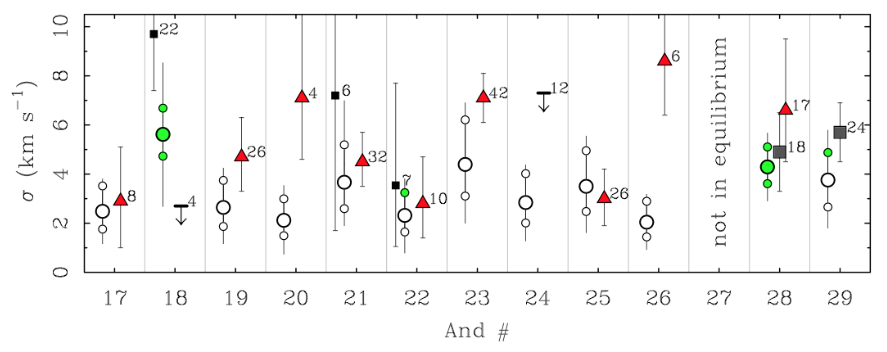Testing Predicted Speeds of Stars in the Dwarf Satellite Galaxies of Andromeda
Previously, we reported here about a test of whether dark matter or modified gravity was responsible for the mass discrepancies observed in extragalactic systems. Stacy McGaugh (Case Western Reserve University) and Moti Milgrom (Weizmann Institute) used the modified gravity theory MOND to predict the velocity dispersions of the stars in the dwarf spheroidal satellites of Andromeda. Dwarf galaxies of this type provide strong tests of MOND because their low surface brightness nature predicts that they should be deep in the modified regime of extremely low acceleration (< 10-10 m s-2; eleven orders of magnitude less than what we feel at the surface of the earth).
Ten of the dwarfs predicted by McGaugh & Milgrom (2013) had not yet at the time been observed kinematically. Since that time, new data have appeared, providing the opportunity to test the a priori predictions. In a new paper, McGaugh & Milgrom compare their predictions to the new data. The result of this comparison is shown in the figure.

|
The predicted and observed velocity dispersions of recently measured dSph satellites of M31. Each bin along the x-axis represents the number of the corresponding dwarf for And XVII through And XXIX. The predictions from McGaugh & Milgrom (2013) are shown without adjustment as circles for M/L = 1 (lower points), 2 (middle points) and 4 in solar units (upper points). Circles are filled if the dwarf is in the isolated regime for the assumed mass-to-light ratio and open if it is dominated by the external field of M31. Error bars propagate all observational uncertainties together with a factor of two uncertainty in the mass-to-light ratio around M/L = 2. Observed velocity dispersions are taken from Tollerud (2012, small squares), Observed velocity dispersions are taken from Tollerud (2013, large squares), and Collins (2013 triangles or, in the case of upper limits, horizontal bars). The number of stars used to determine each velocity dispersion is shown next to the corresponding datum. Points appear in the chronological order of their appearance in the literature from left to right within each bin. Collins (2013) find that And XXVII is not in equilibrium, in contradiction to a necessary assumption of the analysis.
Image credit: Stacy S. McGaugh.
|
The a priori predictions of MOND are realized in the data. In one case, observers found that And XXVII was not in dynamical equilibrium, a necessary assumption of the analysis. In two other cases, And XX and And XXVI, the predictions are in slight tension with the data, but so far only four and six stars have been observed in these dwarfs, respectively. Collins (2013) find that at least eight stars are required for a robust estimate of the velocity dispersion. And XXI provides an example of how the velocity dispersion can change as the number of observed stars increases. In all the remaining dwarfs, which are generally more thoroughly observed, the new data are consistent with the predictions.
The predictive power of MOND in these systems stands in stark contrast to the dark matter paradigm, which makes no comparably clear prediction. One is always free to invoke as much dark matter as needed in each individual case. But there is no agreed way to predict what that should be in advance.
Peñarrubia et al. (2008) do predict that larger dwarfs should have larger velocity dispersions in the dark matter paradigm. In contrast, the velocity dispersion predicted by MOND is either insensitive to the size of the dwarf, or declines with increasing size. It is the expectation of MOND that is realized in the data.
There are two distinct regimes in MOND: the isolated regime in which the stars of the dwarf itself provide the dominant source of gravity, and the regime dominated by the external field effect (EFE) when the gravity of the host (Andromeda in this case) is the dominant source. In the isolated regime, only the stellar mass of the dwarf matters to the predicted velocity dispersion, and not its size. In the EFE case, the predicted velocity dispersion also depends on the size of the dwarf and the strength of the external field. There is a simple criterion delineating which regime is appropriate.
The distinction between isolated and EFE regimes is a unique feature of MOND that is not natural to the dark matter paradigm. Comparing pairs of otherwise similar dwarfs that happen to be in one regime or the other, it is possible to test for this effect. Examples of such pairs are And XVII & And XXVIII, And XVIII & And XXV, and And XVI & And XXI. The difference is subtle, but there does appear to be tentative evidence that the data recognize the distinction predicted by MOND.
It will be interesting to see whether dark matter models can be made to mimic this aspect of MOND. Numerical simulations have already established that the stars visible in dwarfs should be well protected from tidal effects from the host galaxy as they are buried deep in their cocoon of dark matter. The unseen dark matter halo suffers essentially all of the tidal damage right up to the very end of tidal disruption. Only then are the stars measurably affected. This is very different from the expectation of MOND, where the EFE has a notable effect sooner and at a larger distance from the host.
There is a broad consensus that the dark matter paradigm provides the best explanation for cosmology and large scale structure. Yet many aspects of observations of galaxies have now been successfully predicted by MOND. There is, at present, no viable explanation for how this comes to be in the context of dark matter. Clearly the universe still has many lessons to teach us.
